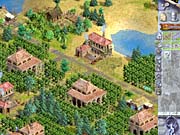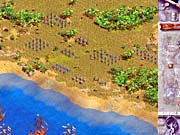German developer Sunflowers' previous game 1602 A.D. was a bestseller in Europe, and the developer's newest game, 1503 A.D., follows closely in its footsteps. Unfortunately, the new game is largely the same as the previous game; while it's true that 1503 A.D. does have a number of changes and improvements over the original game, it's really just more of the same, but fleshed out a bit. Then again, that's not necessarily a bad thing, especially if you enjoyed the original game's engaging and leisurely gameplay. One thing we will note: 1602 A.D.'s voice-overs are, in fact, a bad thing.

You could conceivably call Sunflowers' games "real-time strategy," but they aren't really traditional real-time strategy games in the vein of Starcraft and Command & Conquer. Instead, 1503 A.D. is a "culture-builder" that resembles Blue Byte's Settlers series, in which your task is to carefully nurture your civilization by building different structures and letting your little pioneers expand and grow. Most games begin with a single ship, from which you must establish your colonial empire. This can take a surprising amount of time, and considering the fact that the campaign has 12 missions, the single-player game offers quite a bit of gameplay. 1503 A.D. also includes individual missions and an open-ended sandbox mode--so the game gives you plenty to keep you busy for a while. The only problem is that, despite some improvements, you've seen most of this gameplay already in 1602 A.D..
If you haven't played 1602 A.D. for some time, you might actually think you've loaded up the old game the first time you play 1503 A.D. While the new game has somewhat improved graphics, it's still hardly state of the art and doesn't dramatically change the way the game looks. 1503 A.D. sticks to the original game's presentation in almost every way, from the recycled voice-overs to the tab-heavy interface. You might even recognize some of the musical effects that the previous game "borrowed" from Heroes of Might & Magic II. However, you might have problems with the game's lousy voiceovers.
The game's pace is best described as languid. You set things up and then tweak them as necessary. Your basic task is to start from the contents of a single sailing vessel and develop a thriving settlement (or settlements) on a variety of different terrain types. Your success comes from satisfying your colonists' needs and advancing them through four levels of social strata to the fifth level, aristocrat. This system remains unchanged from the original game, but it still provides a solid foundation for the gameplay. You need to be mindful of issues like city layout, trade relations, and economic planning, which are all influenced by the rather indirect method of placing buildings and setting up trade routes. Half the fun is watching your little colonists go about their business.
However, the previous game had a number of problems, and 1503 A.D. addresses only a few of them. One of the most annoying problems in the previous game was its interface--buildings would all of a sudden sprout giant, rotating question marks, alerting you to a problem without describing what it was. 1503 A.D. at least addresses this by including an icon indicating whether the building is being over- or underutilized, but the game remains far too opaque in terms of feedback that you can use quickly and easily. Rather than including more-comprehensive interface screens or instant pop-up windows, the game relies on tooltips that are only usable because of the game's incredibly slow pace. Until you become quite proficient with the system, figuring out what has gone wrong with your economy (or, rather, precisely how to fix it) can be frustrating and may put off less dedicated players. For extremely patient players, figuring out exactly how to fix problems in your settlements can contribute to a sense of discovery as you figure out exactly why things work the way they do. For others it will just be frustrating. At least the new game has "temperature bars" to indicate the relative desirability of building locations, but on the whole, 1503 A.D.'s interface still isn't ideal.
As you play the game, you'll probably notice the many opportunities the developers could have taken to expand on the previous game. For instance, the game lets you trade with a number of different civilizations (each with its own buildings and attitude), but you're stuck with the same single European civilization you played in 1602 A.D.. That's really unfortunate, because there were a lot of things from the original game that really should have been expanded but, for whatever reason, weren't. Instead, the main difference you'll notice in the sequel is that the combat system has been expanded. But even this isn't a huge expansion, because while there are significantly more unit types and combat formations, the whole thing still seems very primitive.
First of all, calling the game's combat controls "unwieldy" would be an understatement. Cumbersome formation commands, awful pathfinding, and the lack of simple tools such as waypoints make the combat system seem primitive; the naval combat is particularly clumsy. Secondly, while the campaign forces you to fight in certain missions, the open-ended games try to teach you some moral lessons by having the AI respond directly to your level of militarization. If you want to play without any military whatsoever, the AI will politely refrain from arming itself and will restrict itself to trade. If you decide to raise an army, the AI will too. While this lets you, to a large extent, choose whether or not to get involved in combat, it makes the whole military system seem a bit tacked on, since any military challenge by the AI seems self-inflicted.

1503 A.D. is at its best when you play to develop your settlements, just like its predecessor. The game has a linear campaign with a predictably irrelevant story and a series of goal-oriented missions. The campaign does a decent job of giving you different objectives in each mission (you'll do everything from building a colony to rescuing a mismanaged settlement to chasing down a sailing fleet), but the game is really at its best in sandbox mode, in which you simply try to create a settlement and nurture it into a trade empire.
While there is a lot less that's new in this game than you would expect in a sequel released three years after its predecessor, the core gameplay that made the original game engaging remains intact. It may seem like a cliché for game reviews, but if you enjoyed the previous game, you'll probably enjoy 1503 A.D. The new game's slow pace and emphasis on trade and economy over military operations might not seem too exciting for fans of traditional real-time strategy, but those looking for something different may want to give it a try.